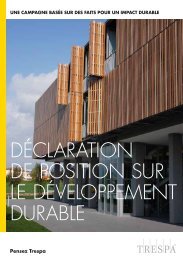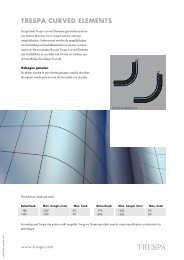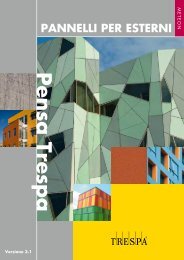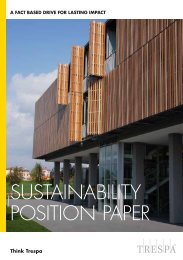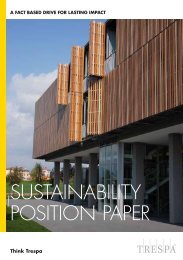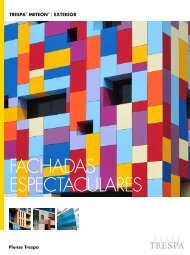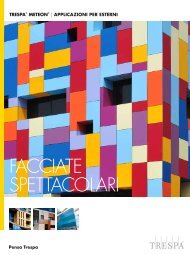SUSTAINABILITY POSITION PAPER - Trespa
SUSTAINABILITY POSITION PAPER - Trespa
SUSTAINABILITY POSITION PAPER - Trespa
- No tags were found...
Create successful ePaper yourself
Turn your PDF publications into a flip-book with our unique Google optimized e-Paper software.
a fact based drive for lasting impact<br />
Sustainability<br />
Position Paper
introduction<br />
<strong>Trespa</strong> is a leading manufacturer of panels<br />
for exterior façade cladding applications<br />
around the globe.<br />
<strong>Trespa</strong>’s management and employees put<br />
License to Operate (LTO) first in their<br />
strategic priorities. LTO includes:<br />
2010 following an initial survey of the<br />
environmental impact of the production<br />
site. This paper consists of 5 chapters:<br />
■<br />
■<br />
■<br />
■<br />
The Health and Safety of employees<br />
and the local community<br />
Product compliance to meet all<br />
regulatory requirements<br />
Transparent reporting and appropriate<br />
behaviour by employees<br />
Sustainability and the preservation<br />
of the Environment<br />
Whilst LTO is ultimately the responsibility<br />
of top management at <strong>Trespa</strong>, the<br />
commitment of all employees is also<br />
required to ensure that these issues<br />
are properly addressed. Sustainability<br />
became part of <strong>Trespa</strong>’s LTO strategy in<br />
1 Philosophy and Beliefs<br />
2 Sustainability Policy<br />
3 Progress<br />
4 Measuring environmental impact<br />
5 Improvement initiatives and targets<br />
As an anchor and guideline to our efforts<br />
on sustainability, we have referred to the<br />
ISO 26000 norm, Guidance on Social<br />
Responsibility. Many of the topics that<br />
we consider to be our LTO priorities are<br />
already incorporated in this ISO 26000<br />
norm under one of the six so-called<br />
core subjects, ranging from “Human<br />
Rights” to “Community Involvement and<br />
2
Development”. 1 We have selected “The<br />
Environment” as a starting point for our<br />
sustainability efforts, which contains the<br />
following four topics:<br />
■<br />
■<br />
■<br />
■<br />
Prevention of pollution<br />
Sustainable resource use<br />
Climate change mitigation and<br />
adaptation<br />
Protection and restoration<br />
of the natural environment<br />
This paper is the second position paper<br />
produced and published by <strong>Trespa</strong> and<br />
describes the initial results and sets the<br />
next targets on the journey to improve<br />
sustainability performance. During the last<br />
two years significant achievements have<br />
been made at improving the accuracy of data<br />
and at reducing waste and energy.<br />
To assess the impact of these achievements,<br />
a new LCA (Life Cycle Assessment) has<br />
been performed by PE International in the<br />
first months of 2012. <strong>Trespa</strong> decided to<br />
communicate the conclusions of this second<br />
LCA, progress achieved so far and a new set<br />
of targets in this second position paper.<br />
As new results or more information becomes<br />
available, <strong>Trespa</strong> will restate its position<br />
again and accordingly issue a new version<br />
of this position paper. In doing so, <strong>Trespa</strong><br />
will clearly outline its progress as well as the<br />
change in its priorities.<br />
1 <br />
For more information about the ISO 26000 norm, see Appendix 1<br />
and http://www.iso.org/iso/home/standards/iso26000.htm<br />
3
1 Philosophy and beliefs<br />
Sustainable development provides <strong>Trespa</strong> with<br />
challenges as well as new opportunities<br />
Common sense<br />
As in many of its business decisions <strong>Trespa</strong><br />
will use common sense in addressing<br />
the topic of sustainable development.<br />
This implies avoidance of philosophies<br />
and dogmas and choosing to base the<br />
sustainability strategy on measurement<br />
of environmental impacts.<br />
Objective and fact based<br />
<strong>Trespa</strong> believes in objective and fact based<br />
analysis and has performed an LCA to<br />
map its environmental footprint along the<br />
entire value chain. Though many different<br />
methods exist, <strong>Trespa</strong> believes that the LCA,<br />
as described in ISO 14040 and ISO 14044,<br />
is currently the most objective and fact<br />
based method to measure its environmental<br />
footprint, that is available. This is supported<br />
by an increasing number of certifications<br />
relying on this methodology. Although<br />
it will pursue certification, this is not the<br />
backbone of <strong>Trespa</strong>’s sustainability policy.<br />
The LCA for <strong>Trespa</strong> has been performed and<br />
validated by one of the leading consultants<br />
in the area of sustainable development,<br />
and will form the basis for all of <strong>Trespa</strong>’s<br />
improvement initiatives. However, <strong>Trespa</strong><br />
will continue to monitor alternative<br />
available methodologies and adopt ones<br />
that are understandable, transparent and<br />
standardized and that promote lasting<br />
improvements.<br />
Integral part of business planning<br />
and review cycle<br />
To achieve change <strong>Trespa</strong> will set priorities<br />
based on its LCA and agree realistic but<br />
challenging targets. In line with other<br />
License to Operate topics, <strong>Trespa</strong> has<br />
integrated all sustainability issues into<br />
its rolling business planning and review<br />
cycle. This cycle consists of annual target<br />
setting in the budgeting round, a monthly<br />
management review of progress against<br />
KPIs and inclusion of sustainability in the<br />
annual report.<br />
4
2 Sustainability Policy<br />
The basis of <strong>Trespa</strong>’s sustainability policy is a<br />
strong belief that any change should start<br />
with the company itself.<br />
Do No Harm<br />
<strong>Trespa</strong>’s first task is to comply with<br />
the safety, product and sustainability<br />
regulations and guidelines set by the<br />
countries in which it operates.<br />
In addition, <strong>Trespa</strong> is looking for<br />
opportunities to minimize the impact<br />
of its operations and products.<br />
Do Better<br />
Finally, <strong>Trespa</strong> believes that investing<br />
in sustainable development should be<br />
beneficial to the long term position of the<br />
company. Many sustainability challenges<br />
constitute opportunities that make good<br />
business sense today and will allow the<br />
company to continue to grow.<br />
Do Good<br />
The second element of <strong>Trespa</strong>’s policy is that<br />
it strives to help its suppliers and customers<br />
realize their sustainability challenges. This<br />
means that <strong>Trespa</strong> looks for opportunities<br />
to maximize the sustainability contribution<br />
of its products in the value chain, including<br />
their end-use, e.g. façade cladding.<br />
Moreover, <strong>Trespa</strong> will continue to look for<br />
opportunities and initiatives to support<br />
and promote longer term sustainable<br />
development beyond the direct scope of its<br />
current operations.<br />
5
3 Progress<br />
Improving information from 2009<br />
to 2011 Life Cycle Assessment<br />
The 2009 LCA led to three clear focal points<br />
for <strong>Trespa</strong>’s sustainability efforts. For each<br />
of those focal points, <strong>Trespa</strong> communicated<br />
targets in the previous position paper.<br />
The focal points were:<br />
1. Upstream contributions from raw<br />
material production and transport<br />
2. Onsite emissions originating from<br />
resin production and impregnation<br />
3. Primary energy use for <strong>Trespa</strong>’s own<br />
production processes<br />
In performing the 2009 LCA <strong>Trespa</strong> came to<br />
the conclusion that it needed more detailed<br />
information on each of these topics in<br />
order to successfully address them. For this<br />
reason, <strong>Trespa</strong> started a dialogue with its<br />
Kraft paper suppliers to get more detailed<br />
information on material and energy usage<br />
during the Kraft paper production process.<br />
While the process of gathering more data is<br />
still on-going, detailed information has been<br />
received from some major suppliers, which<br />
shows the original assumptions to be poor.<br />
These new, more specific data have been<br />
incorporated in the 2011 LCA.<br />
Internally, <strong>Trespa</strong> put a lot of effort in<br />
improving the accuracy of the mass and<br />
energy balances. This led to an improved<br />
insight into material usage and waste<br />
reduction opportunities. As a result, the<br />
relative waste production has been reduced<br />
by over 10% during the first half of 2012.<br />
Although no targets have been set for onsite<br />
emissions, new information enabled <strong>Trespa</strong><br />
to improve its environmental profile.<br />
As a specific action, acetone as a solvent<br />
was removed from the production process.<br />
Furthermore, all refrigeration and cooling<br />
equipment containing the R22 cooling agent<br />
have been replaced.<br />
Regarding the third focal point, a detailed<br />
energy balance was established for the <strong>Trespa</strong><br />
manufacturing process, including a monthly<br />
electricity and gas consumption overview.<br />
This led to improved insight in energy<br />
usage and consequently, the relative energy<br />
consumption has been reduced by more than<br />
3% since the previous position paper.<br />
6
As a specific action, high energy consuming<br />
computers in the plant have been replaced<br />
by low energy satellites and a high energy<br />
consuming server has been switched off.<br />
Also regarding steam consumption, more<br />
detailed, equipment specific, information<br />
was gathered and tracked on a monthly<br />
basis. This led to a plan to install high<br />
efficiency steam boilers and increase<br />
the recovery of off gas heat from the<br />
impregnation off gas burner, which will be<br />
executed in the near future. The next chart<br />
shows the trend of the relative electricity<br />
consumption, gas consumption and waste<br />
generated. Finally, the PEFC chain-ofcustody<br />
certificate has been achieved, which<br />
is part of <strong>Trespa</strong>’s responsible sourcing<br />
strategy.<br />
110<br />
105<br />
RELATIVE INDEXED ENERGY<br />
CONSUMPTION AND <strong>PAPER</strong><br />
WASTE GENEARTION<br />
(KWH/TON, M3/TON<br />
OR KG/TON)<br />
100<br />
95<br />
90<br />
85<br />
REL. ELECTRICITY CONS.<br />
REL. GAS CONS.<br />
2009 2010 2011<br />
100 96,5 97,0<br />
100 107,9 108,1<br />
REL. <strong>PAPER</strong> WASTE 100<br />
95,0 100,8<br />
7
4 Measuring<br />
environmental impact<br />
A second LCA of <strong>Trespa</strong>, based on full<br />
year 2011 data, has been carried out in the<br />
first months of 2012 with the help of PE<br />
International, a leading consultant in<br />
this area.<br />
The LCA has been performed from a ‘cradleto-gate’<br />
perspective that basically looks at the<br />
total impact of the manufacturing footprint<br />
including the extraction and processing<br />
of raw materials as well as transport to the<br />
manufacturing site for all products produced<br />
by <strong>Trespa</strong>. The results are presented in the<br />
table below. The units are based on the<br />
production of 1 ton of <strong>Trespa</strong> HPL. The<br />
analysis excludes the effects during the<br />
use and end of life phase which have to be<br />
analysed on a specific product level.<br />
Six key environmental indicators commonly<br />
agreed as most relevant were selected by<br />
PE International based on their inclusion<br />
in Environmental Product Declarations<br />
(EPDs). EPD’s are the leading documents to<br />
publish sustainability results. Based on the<br />
2009 LCA results, <strong>Trespa</strong> is finalizing EPDs<br />
according to the French (FDES), German<br />
(IBU) and British (BREEAM) standard.<br />
The LCA parameters included in EPDs cover<br />
emissions of substances with a negative<br />
impact on the environment (air, water and<br />
soil), emissions of greenhouse gases that<br />
contribute to climate change and depletion<br />
of energy resources both non-renewable and<br />
renewable. These indicators are listed and<br />
explained in Appendix 2.<br />
Per ton HPL<br />
Environmental<br />
impact<br />
dimensions<br />
Units<br />
total<br />
2009 lca<br />
total<br />
2011 lca<br />
raw<br />
material<br />
contribution<br />
trespa<br />
contribution<br />
Acidification (AP) Kg SO 2<br />
-Equiv. 5.6 10 85% 15%<br />
Emissions to<br />
air, water<br />
and soil<br />
Eutrophication (EP) Kg P-Equiv. 0.88 1.10 75% 25%<br />
Ozone Depletion Potential<br />
(ODP)<br />
Kg R11-Equiv. 8.5E-05 8.9E-05 99% 1%<br />
Photochemical Ozone<br />
creation (POCP)<br />
Kg Ethene-Equiv. 0.85 1.02 72% 28%<br />
Primary energy<br />
consumption<br />
and carbon<br />
footprint<br />
Total Primary<br />
Energy<br />
GJ 65 73.3 63% 37%<br />
Carbon footprint (GWP) Kg CO 2<br />
-Equiv. 900 1560 39% 61%<br />
Renewable<br />
energy share<br />
% 29 27 97% 3%<br />
8
The 2011 LCA is updated with more accurate<br />
information on the environmental profile of<br />
the paper used in the manufacture of <strong>Trespa</strong><br />
HPL. The generic Kraft paper data used<br />
previously was replaced with the saturated<br />
Kraft core paper data from a leading supplier<br />
to <strong>Trespa</strong>. This paper was found to have a<br />
significant higher environmental impact<br />
than the Kraft liner paper values used in the<br />
2009 LCA, as can be concluded from the<br />
abovementioned table. <strong>Trespa</strong> is expecting<br />
to receive Kraft paper data from other<br />
suppliers at the end of 2012 as well, after<br />
which the 2011 LCA results will be updated<br />
accordingly.<br />
In the following diagram the relative<br />
contribution of the different steps from<br />
cradle to gate is presented.<br />
Based on these results, PE International<br />
made the following recommendations:<br />
■ Complete the data collection from Kraft<br />
paper suppliers; utilize the data to make<br />
a more sustainable paper choice and<br />
to engage Kraft paper suppliers into<br />
environmental improvement actions.<br />
■ Shift the core material from paper to<br />
wood chips. Initiate a discussion with<br />
chips supplier to potentially collect data<br />
from them.<br />
PE’s recommendations have been taken<br />
into account when <strong>Trespa</strong> set the new<br />
improvement initiatives outlined in the next<br />
paragraph.<br />
POCP<br />
EP<br />
AP<br />
ODP<br />
PRODUCTION OF<br />
RAW MATERIALS<br />
PRODUCTION OF<br />
ENERGY AND FUELS (OFFSITE)<br />
TRANSPORT<br />
EMISSIONS ON SITE<br />
WASTE TREATMENT<br />
GWP<br />
0% 20% 40% 60% 80% 100%<br />
Cradle to gate<br />
9
5 Improvement Initiatives<br />
2013 - 2015<br />
Reduction of upstream contributions<br />
and primary energy consumption<br />
As the 2012 LCA clearly indicates,<br />
the impact of the raw materials on<br />
<strong>Trespa</strong>’s environmental profile increased<br />
significantly. The second biggest factor is<br />
and remains the use of primary energy on<br />
site. Therefore, the improvement initiatives<br />
2013-2015 are aimed at:<br />
■ Upstream contributions from raw<br />
material production and transport<br />
■ Primary energy use for <strong>Trespa</strong>’s own<br />
production processes<br />
To ensure progress and positive impact<br />
on <strong>Trespa</strong>’s environmental profile and thus<br />
LCA, <strong>Trespa</strong> has added the following list of<br />
targets to its business planning:<br />
Reduction of upstream contributions:<br />
■ Reduction of the relative amount of waste<br />
(in kg/ton <strong>Trespa</strong> HPL) by 15% at the end<br />
of 2015 compared to end of 2011.<br />
■ Further detail the specific contributions<br />
of Kraft paper with <strong>Trespa</strong>’s suppliers<br />
and get into dialogue to reduce their<br />
environmental impact.<br />
■ Detail the specific contributions of<br />
chemicals and of woodchips with<br />
<strong>Trespa</strong>’s suppliers.<br />
Reduction of primary energy<br />
consumption:<br />
■ In line with the Multiyear agreement of<br />
the Dutch government with the industry,<br />
<strong>Trespa</strong> aims at reducing the relative<br />
energy consumption (in GJ/ton <strong>Trespa</strong><br />
HPL) by 8% at the end of 2015 compared<br />
to end of 2011. Amongst others, this<br />
includes replacing all lights in the factory<br />
and in the offices by LED lights.<br />
In addition to these operational targets,<br />
<strong>Trespa</strong> will focus on implementing the<br />
proper certification required in the market,<br />
such as FSC or PEFC certification.<br />
To assess the impact of these initiatives and<br />
to include new information, <strong>Trespa</strong> intends<br />
to perform a new LCA in 2014, based on full<br />
year 2013 data.<br />
10
APPENDIX 1<br />
ISO 26000 information<br />
Social responsibility: 7 core subjects<br />
HOLISTIC APPROACH<br />
6.8*<br />
COMMUNITY<br />
INVOLVEMENT<br />
AND DEVELOPMENT<br />
6.3*<br />
HUMAN RIGHTS<br />
6.7*<br />
CONSUMER<br />
ISSUES<br />
ORGANIZATION<br />
6.2*<br />
ORGANIZATIONAL<br />
GOVERNANCE<br />
6.4*<br />
LABOUR<br />
PRACTICES<br />
6.6*<br />
FAIR OPERATING<br />
PRACTICES<br />
6.5*<br />
THE ENVIRONMENT<br />
INTERDEPENDENCE<br />
*The figure denote the corresponding clause numbers in ISO 26000<br />
11
Guidance on Social Responsibility<br />
from ISO 26000 including the priority areas<br />
Core subjects and issues<br />
Adressed in sub-clause<br />
Core subject: Organizational governance 6.2<br />
Decision-making processes and structures 6.2.3<br />
Core subject: Human rights 6.2<br />
Issue 1: Due diligence 6.3.3<br />
Issue 2: Human rights risk situations 6.3.4<br />
Issue 3: Avoidance of complicity 6.3.5<br />
Issue 4: Resolving grievances 6.3.6<br />
Issue 5: Discrimination and vulnerable groups 6.3.7<br />
Issue 6: Civil and political rights 6.3.8<br />
Issue 7: Economic, social and cultural rights 6.3.9<br />
Issue 8: Fundamental rights at work 6.3.10<br />
Core subject: Labour Practices 6.4<br />
Issue 1: Employment and employment relationships 6.4.3<br />
Issue 2: Conditions of work and social protection 6.4.4<br />
Issue 3: Social dialogue 6.4.5<br />
Issue 5: Human development and training in the workplace 6.4.7<br />
Core subject: The environment 6.5<br />
Issue 1: Prevention of pollution 6.5.3<br />
Issue 2: Sustainable resource use 6.5.4<br />
Issue 3: Climate change mitigation and adaptation 6.5.5<br />
Issue 4: Protection and restoration<br />
of the natural environment<br />
6.5.6<br />
12
Core subject: Fair operating practices 6.6<br />
Issue 1: Anti–corruption 6.6.3<br />
Issue 2: Responsible political involvement 6.6.4<br />
Issue 3: Fair competition 6.6.5<br />
Issue 4: Promoting social responsibility in the sphere of influence 6.6.6<br />
Issue 5: Respect for property rights 6.6.7<br />
Core subject: Consumer issues 6.7<br />
Issue 1: Fair marketing, information and contractual practices 6.7.3<br />
Issue 2: Protecting consumers’ health and safety 6.7.4<br />
Issue 3: Sustainable consumption 6.7.5<br />
Issue 4: Consumer service, support, and dispute resolution 6.7.6<br />
Issue 5: Consumer data protection and privacy 6.7.7<br />
Issue 6: Access to essential services 6.7.8<br />
Issue 7: Education and awareness 6.7.9<br />
Core subject: Community involvement and development 6.8<br />
Issue 1: Community involvement 6.8.3<br />
Issue 2: Education and culture 6.8.4<br />
Issue 3: Employment creation and skills development 6.8.5<br />
Issue 4: Technology development 6.8.6<br />
Issue 5: Wealth and income creation 6.8.7<br />
Issue 6: Health 6.8.8<br />
Issue 7: Social investment 6.8.9<br />
13
APPENDIX 2<br />
LCA environmental indicators<br />
Emissions parameters<br />
Acidification Potential (AP) gauging the effect of releasing acids into environment ultimately<br />
leading to phenomena like acid rain<br />
Eutrophication Potential (EP) measuring the effect of releasing excessive amounts of<br />
nutrients into surface water which reduces the oxygen content in the water and kills aquatic life.<br />
Ozone Depletion Potential (ODP) measuring the effects of gas emissions ultimately leading<br />
to breaks in the earth’s protective ozone layer with all the associated detrimental effects on life.<br />
Well-known but fortunately banned contributors to ozone depletion are CFC gasses.<br />
Photochemical Ozone Creation Potential (POCP) gauging the emissions of gasses with<br />
negative impact on the local environment resulting in the buildup of summer smog.<br />
Climate change parameters<br />
Global Warming Potential (GWP) is the emission of greenhouse gasses leading to climate<br />
change. This dimension is also known as the carbon footprint and is measured in equivalent<br />
emission of carbon dioxide. Burning fossil fuels is the major source of GWP, but carbon capture<br />
in raw materials such as wood can off-set these emissions.<br />
Resource depletion parameters<br />
Primary energy usage is the energy required to produce one unit of product.<br />
Share of renewable energy providing the share of energy coming from renewable sources<br />
like sun and wind.<br />
14
DISCLAIMER<br />
General<br />
These terms apply to the use of this document and such use automatically<br />
means that the other party agrees to these terms. The information<br />
provided by <strong>Trespa</strong> International B.V. (“<strong>Trespa</strong>”) in this document<br />
is solely indicative. <strong>Trespa</strong> is unable to warrant the accuracy and<br />
completeness of this information. <strong>Trespa</strong> may change the information<br />
included in this document at any time and without further notice.<br />
<strong>Trespa</strong>’s customers and third parties must ascertain that they have the<br />
most recent document (for the most recent version, please consult: www.<br />
trespa.com). No rights can be derived from the information provided;<br />
the use of the information is at the other party’s risk and responsibility.<br />
<strong>Trespa</strong> does not warrant that the information in this document is<br />
suitable for the purpose for which it is consulted by the other party. This<br />
document does not contain any design, structural calculation, estimate<br />
or other warranty or representation that customers and third parties<br />
may rely on. This document does not guarantee any properties of <strong>Trespa</strong><br />
products. Colours used in <strong>Trespa</strong>’s communications (including but<br />
not limited to printed matter) and in samples of <strong>Trespa</strong>’s products may<br />
differ from the colours of the <strong>Trespa</strong> products to be supplied. Samples<br />
are not intended for use in product tests and are not representative of<br />
characteristics of the <strong>Trespa</strong> products. <strong>Trespa</strong>’s products and samples<br />
are produced within the specified colour tolerances and the colours (of<br />
production batches) may differ, even if the same colour is used. The<br />
viewing angle also influences the colour perception. Metallics panels<br />
feature a surface whose colour appears to change based on the direction<br />
from which it is viewed. The specified colour stability and colour<br />
specifications relate only to the decorative surface of the <strong>Trespa</strong> products,<br />
not to the core material and samples of the <strong>Trespa</strong> products. <strong>Trespa</strong><br />
products are delivered ex-works with straight, sawn sides. Customers<br />
and third parties must have a professional adviser inform them about<br />
(the suitability of) the <strong>Trespa</strong> products for all desired applications and<br />
about applicable laws and regulations. <strong>Trespa</strong> does not warrant the above.<br />
The most recent version of the current delivery programme and the<br />
Material Properties Datasheet can be found at www.trespa.info. Only the<br />
information in the most recent and valid Material Properties Datasheet<br />
should be used to select and provide advice regarding <strong>Trespa</strong> products.<br />
<strong>Trespa</strong> reserves the right to change (the specifications for) its products<br />
without prior notice.<br />
Liability<br />
<strong>Trespa</strong> is not liable (neither contractual nor non-contractual) for any<br />
damage arising from or related to the use of this document, except if<br />
and to the extent that such damage is the result of wilful misconduct<br />
or gross negligence on the part of <strong>Trespa</strong> and/or its management. The<br />
limitation of liability applies to all parties affiliated with <strong>Trespa</strong>, including<br />
but not limited to its officers, directors, employees, affiliated enterprises,<br />
suppliers, distributors, agents, and representatives.<br />
General conditions<br />
All oral and written statements, offers, quotations, sales, supplies,<br />
deliveries and/or agreements and all related activities of <strong>Trespa</strong> are<br />
governed by the <strong>Trespa</strong> General Terms and Conditions of Sale (Algemene<br />
verkoopvoorwaarden <strong>Trespa</strong> International B.V.) filed with the Chamber of<br />
Commerce and Industry for Noord- en Midden- Limburg in Venlo (NL)<br />
on 11 April 2007 under number 24270677, which can be found on and<br />
downloaded from the <strong>Trespa</strong> website, www.trespa.com/documentation.<br />
All oral and written statements, offers, quotations, sales, supplies,<br />
deliveries and/or agreements and all related work of <strong>Trespa</strong> North<br />
America, Ltd. are governed by the <strong>Trespa</strong> North America General Terms<br />
and Conditions of Sale, which can be found on and downloaded from<br />
the <strong>Trespa</strong> website, www.trespa.com/documentation. A copy of these<br />
general conditions of sale will be provided free of charge on request.<br />
All general terms and conditions other than the conditions mentioned<br />
above are dismissed and do not apply, regardless of whether such terms<br />
and conditions are referred to on requests for offers, offer confirmations,<br />
stationery and/or other documents of the other party, even if <strong>Trespa</strong> does<br />
not expressly object to such terms and conditions.<br />
Intellectual property<br />
All intellectual property rights and other rights regarding the content<br />
of this document (including logos, text and photographs) are owned by<br />
<strong>Trespa</strong> and/or its licensors. Any use of the content of this document,<br />
including distribution, reproduction, disclosure, storage in an automated<br />
data file or the dispatch of such a file without <strong>Trespa</strong>’s prior written<br />
consent is explicitly prohibited. ® <strong>Trespa</strong>, Meteon, Athlon, TopLab,<br />
TopLab PLUS , TopLab ECO-FIBRE , Virtuon, Volkern, <strong>Trespa</strong> Essentials and<br />
Mystic Metallics are registered trademarks of <strong>Trespa</strong>.<br />
Questions<br />
Should you have any questions or comments, please do not hesitate to<br />
contact <strong>Trespa</strong>.<br />
15
CONTACT US<br />
<strong>Trespa</strong> International B.V.<br />
P.O. Box 110, 6000 AC Weert<br />
Wetering 20, 6002 SM Weert<br />
The Netherlands<br />
www.trespa.com<br />
Customer Service Desk<br />
EMEA Export<br />
Tel: +31 (0) 495 458 359 / 573<br />
Fax: +31 (0) 495 458 383<br />
Info.Export@<strong>Trespa</strong>.com<br />
Customer Service Desk<br />
The Netherlands<br />
Tel: +31 (0) 495 458 850<br />
Fax: +31 (0) 495 540 535<br />
Info.Nederland@<strong>Trespa</strong>.com<br />
<strong>Trespa</strong> Belgium bvba/Sprl<br />
H. van Veldekesingel 150 B. 19<br />
3500 Hasselt<br />
Belgium<br />
Tel: 0800 15501<br />
Fax: 0800 15503<br />
Info.Belgium@<strong>Trespa</strong>.com<br />
Grand Duché de Luxembourg<br />
Tel: +31 (0) 495 458 308<br />
<strong>Trespa</strong> Deutschland gmbh<br />
Europaallee 27, D-50226 Frechen<br />
Germany<br />
Tel: 0800 186 04 22<br />
Fax: 0800 186 07 33<br />
Info.Deutschland@<strong>Trespa</strong>.com<br />
<strong>Trespa</strong> UK Ltd.<br />
Grosvenor House<br />
Hollinswood Road<br />
Central Park, Telford<br />
Shropshire, TF2 9TW<br />
United Kingdom<br />
Tel: +44 (0) 1952 290707<br />
Fax: +44 (0) 1952 290101<br />
Info.UK@<strong>Trespa</strong>.com<br />
<strong>Trespa</strong> France s.a.r.l.<br />
14 Place Georges Pompidou<br />
78180 Montigny-le-Bretonneux<br />
France<br />
Tel: +33 (0) 1 34 98 16 67<br />
Fax: +33 (0) 1 34 98 16 68<br />
Info.France@<strong>Trespa</strong>.com<br />
<strong>Trespa</strong> Iberia<br />
Calle Ribera 5,<br />
08003 Barcelona<br />
Spain<br />
Tel: +34 (0) 93 315 04 47<br />
Fax: +34 (0) 93 516 02 12<br />
Info.Iberia@<strong>Trespa</strong>.com<br />
<strong>Trespa</strong> North America Ltd.<br />
62 Greene Street (Ground Floor)<br />
New York, NY 10012<br />
United States of America<br />
Tel: +1 800 487 3772<br />
Fax: +1 866 298 3499<br />
Info.NorthAmerica@<strong>Trespa</strong>.com<br />
<strong>Trespa</strong> Chile Ltda.<br />
Eliodoro Yáñez 2831<br />
Torre A - Local 1<br />
Providencia, Santiago<br />
Chile<br />
Tel: +56 2 4069990<br />
Info.Chile@<strong>Trespa</strong>.com<br />
High Quality Panels<br />
s. de R.L de C.V.<br />
Avenida de Providencia 2434-A<br />
Colonia Providencia<br />
Guadalajara, Jalisco<br />
México CP 44630<br />
Tel: +52 (33) 12020189 /<br />
12020250<br />
Fax: +52 (33) 12020189<br />
info@highqualitypanels.com<br />
www.highqualitypanels.com<br />
<strong>Trespa</strong> China Co. ltd.<br />
Room 2604-05, HuaiHai Plaza<br />
No. 1045 HuaiHai Road (central)<br />
ShangHai 200031<br />
P.R. China<br />
Tel: +86 (0) 21 6288 1299<br />
Fax: +86 (0) 21 6288 1296<br />
Info.China@<strong>Trespa</strong>.com<br />
Customer Service Desk<br />
Asia/Pacific<br />
Tel: +86 (0) 21 5465 8388<br />
Fax: +86 (0) 21 5465 6989<br />
Info.APAC@<strong>Trespa</strong>.com<br />
VISIT US<br />
<strong>Trespa</strong> Design Centre<br />
New York<br />
62 Greene Street (Ground Floor)<br />
New York, NY 10012<br />
United States of America<br />
Tel: +1 212 334 6888<br />
Fax: +1 866 298 3499<br />
TDC.NewYork@<strong>Trespa</strong>.com<br />
www.trespa.com/tdc<br />
<strong>Trespa</strong> Design Centre<br />
Weert<br />
Wetering 20<br />
6002 SM Weert<br />
The Netherlands<br />
Tel: +31 (0) 495 458 845<br />
TDC.Weert@<strong>Trespa</strong>.com<br />
www.trespa.com/tdc<br />
<strong>Trespa</strong> Design Centre<br />
Barcelona<br />
Calle Ribera 5,<br />
08003 Barcelona<br />
Spain<br />
Tel: +34 (0) 93 295 4193<br />
Fax: +34 (0) 93 116 3300<br />
TDC.Barcelona@<strong>Trespa</strong>.com<br />
www.trespa.com/tdc<br />
<strong>Trespa</strong> Design Centre<br />
Santiago<br />
Eliodoro Yáñez 2831<br />
Torre A - Local 1<br />
Providencia, Santiago<br />
Chile<br />
Tel: +56 2 4069990<br />
TDC.Santiago@<strong>Trespa</strong>.com<br />
www.trespa.com/tdc<br />
Version 2.0 ■ brochure Code U2501 ■ Date 11-2012<br />
visit trespa.com for the most<br />
up to date version of this document.



